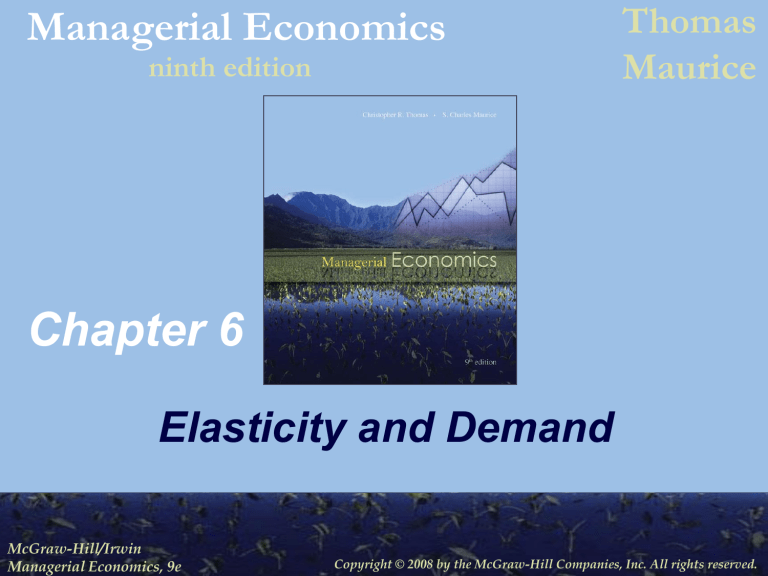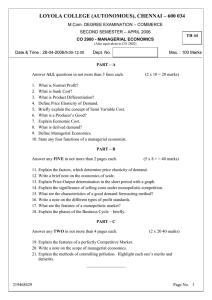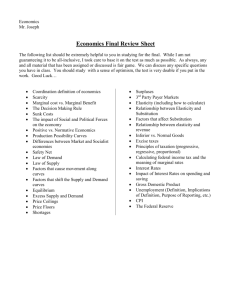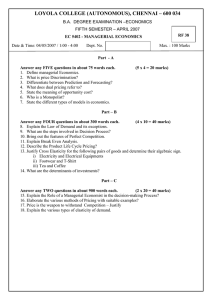
Managerial Economics
ninth edition
Thomas
Maurice
Chapter 6
Elasticity and Demand
McGraw-Hill/Irwin
McGraw-Hill/Irwin
Managerial Economics, 9e
Managerial Economics, 9e
Copyright © 2008 by the McGraw-Hill Companies, Inc. All rights reserved.
Managerial Economics
Price Elasticity of Demand (E)
• Measures responsiveness or sensitivity
of consumers to changes in the price of
a good
•
%Q
E
%P
• P & Q are inversely related by the law of
demand so E is always negative
• The larger the absolute value of E, the more
sensitive buyers are to a change in price
6-2
Managerial Economics
Price Elasticity of Demand (E)
Table 6.1
Elasticity
6-3
Responsiveness
E
Elastic
%Q%P E 1
Unitary Elastic
%Q%P E 1
Inelastic
%Q%P E 1
Managerial Economics
Price Elasticity of Demand (E)
• Percentage change in quantity
demanded can be predicted for a given
percentage change in price as:
• %Qd = %P x E
• Percentage change in price required for
a given change in quantity demanded
can be predicted as:
• %P = %Qd ÷ E
6-4
Managerial Economics
Price Elasticity & Total Revenue
Table 6.2
6-5
Elastic
Unitary elastic
Inelastic
%Q%P
%Q%P
%Q%P
Quantity-effect
dominates
No dominant
effect
Price-effect
dominates
Price
rises
TR falls
No change in TR
TR rises
Price
falls
TR rises
No change in TR
TR falls
Managerial Economics
Factors Affecting Price Elasticity
of Demand
• Availability of substitutes
• The better & more numerous the
substitutes for a good, the more elastic is
demand
• Percentage of consumer’s budget
• The greater the percentage of the
consumer’s budget spent on the good, the
more elastic is demand
• Time period of adjustment
• The longer the time period consumers have
to adjust to price changes, the more elastic
is demand
6-6
Managerial Economics
Calculating Price Elasticity of
Demand
• Price elasticity can be calculated
by multiplying the slope of demand
(Q/P) times the ratio of price to
quantity (P/Q)
Q
100
Q P
Q
%Q
E
P
P Q
%P
100
P
6-7
Managerial Economics
Calculating Price Elasticity of
Demand
• Price elasticity can be measured at
an interval (or arc) along demand,
or at a specific point on the
demand curve
• If the price change is relatively small, a
point calculation is suitable
• If the price change spans a sizable arc
along the demand curve, the interval
calculation provides a better measure
6-8
Managerial Economics
Computation of Elasticity Over an
Interval
• When calculating price elasticity of
demand over an interval of
demand, use the interval or arc
elasticity formula
Q Average P
E
P Average Q
6-9
Managerial Economics
Computation of Elasticity at a
Point
• When calculating price elasticity at a
point on demand, multiply the slope of
demand (Q/P), computed at the point
of measure, times the ratio P/Q, using
the values of P and Q at the point of
measure
• Method of measuring point elasticity
depends on whether demand is linear or
curvilinear
6-10
Managerial Economics
Point Elasticity When Demand is
Linear
Given Q a bP cM dPR , let income &
price of the related good take specific
ˆ and Pˆ , respectively
values M
R
Then express demand as Q a' bP , where
ˆ dPˆ and the slope parameter
a' a cM
R
is b Q P
6-11
Managerial Economics
Point Elasticity When Demand is
Linear
• Compute elasticity using either of the two
formulas below which give the same value
for E
P
E b
Q
P
or E
PA
Where P and Q are values of price and quantity demanded
at the point of measure along demand, and A ( a'/ b )
is the price-intercept of demand
6-12
Managerial Economics
Point Elasticity When Demand is
Curvilinear
• Compute elasticity using either of two
equivalent formulas below
Q P
P
E
P Q P A
Where Q P is the slope of the curved demand at
the point of measure, P and Q are values of price and
quantity demanded at the point of measure, and A is
the price-intercept of the tangent line extended to
cross the price-axis
6-13
Managerial Economics
Elasticity (Generally) Varies Along
a Demand Curve
• For linear demand, price and Evary
directly
• The higher the price, the more elastic is
demand
• The lower the price, the less elastic is
demand
• For curvilinear demand, no general rule
about the relation between price and
quantity
Special case of Q aP b which has a constant
price elasticity (equal to b) for all prices
6-14
Managerial Economics
Constant Elasticity of Demand
(Figure 6.3)
6-15
Managerial Economics
Marginal Revenue
• Marginal revenue (MR) is the change
in total revenue per unit change in
output
• Since MR measures the rate of
change in total revenue as quantity
changes, MR is the slope of the total
revenue (TR) curve
TR
MR
Q
6-16
Managerial Economics
Demand & Marginal Revenue
(Table 6.3)
6-17
TR = P Q
MR = TR/Q
Unit sales (Q)
Price
0
$4.50
1
4.00
$4.00
$4.00
2
3.50
$7.00
$3.00
3
3.10
$9.30
$2.30
4
2.80
$11.20
$1.90
5
2.40
$12.00
$0.80
6
2.00
$12.00
$0
7
1.50
$10.50
$-1.50
$
0
--
Managerial Economics
Demand, MR, & TR
Panel A
6-18
(Figure 6.4)
Panel B
Managerial Economics
Demand & Marginal Revenue
• When inverse demand is linear,
= A + BQ (A > 0, B < 0)
• Marginal revenue is also linear,
intersects the vertical (price) axis at
the same point as demand, & is twice
as steep as demand
MR = A + 2BQ
6-19
P
Managerial Economics
Linear Demand, MR, & Elasticity
(Figure 6.5)
6-20
Managerial Economics
MR, TR, & Price Elasticity
Table 6.4
Marginal
Total revenue
revenue
MR > 0 TR increases as
Q increases
MR = 0
MR < 0
(P decreases)
Unitelastic
elastic
Unit
TR is maximized
(E=
(E=
1) 1)
TR decreases as Inelastic
Inelastic
Q increases
(E<
1) 1)
(E<
(P decreases)
6-21
Price elasticity
of demand
Elastic
Elastic
(E>
1) 1)
(E>
Managerial Economics
Marginal Revenue & Price Elasticity
• For all demand & marginal revenue
curves, the relation between marginal
revenue, price, & elasticity can be
expressed as
1
MR P 1
E
6-22
Managerial Economics
Income Elasticity
• Income elasticity (EM) measures the
responsiveness of quantity demanded
to changes in income, holding the price
of the good & all other demand
determinants constant
• Positive for a normal good
• Negative for an inferior good
EM
6-23
%Qd Qd M
%M
M Qd
Managerial Economics
Cross-Price Elasticity
• Cross-price elasticity (EXY) measures the
responsiveness of quantity demanded of
good X to changes in the price of related
good Y, holding the price of good X & all
other demand determinants for good X
constant
• Positive when the two goods are substitutes
• Negative when the two goods are complements
E XY
6-24
%QX QX PY
%PY
PY QX
Managerial Economics
Interval Elasticity Measures
• To calculate interval measures of
income & cross-price elasticities, the
following formulas can be employed
6-25
EM
Q Average M
M Average Q
E XR
Q Average PR
PR Average Q
Managerial Economics
Point Elasticity Measures
6-26
For the linear demand function
QX a bPX cM dPY , point
measures of income & cross-price
elasticities can be calculated as
EM
M
c
Q
E XR
PR
d
Q





